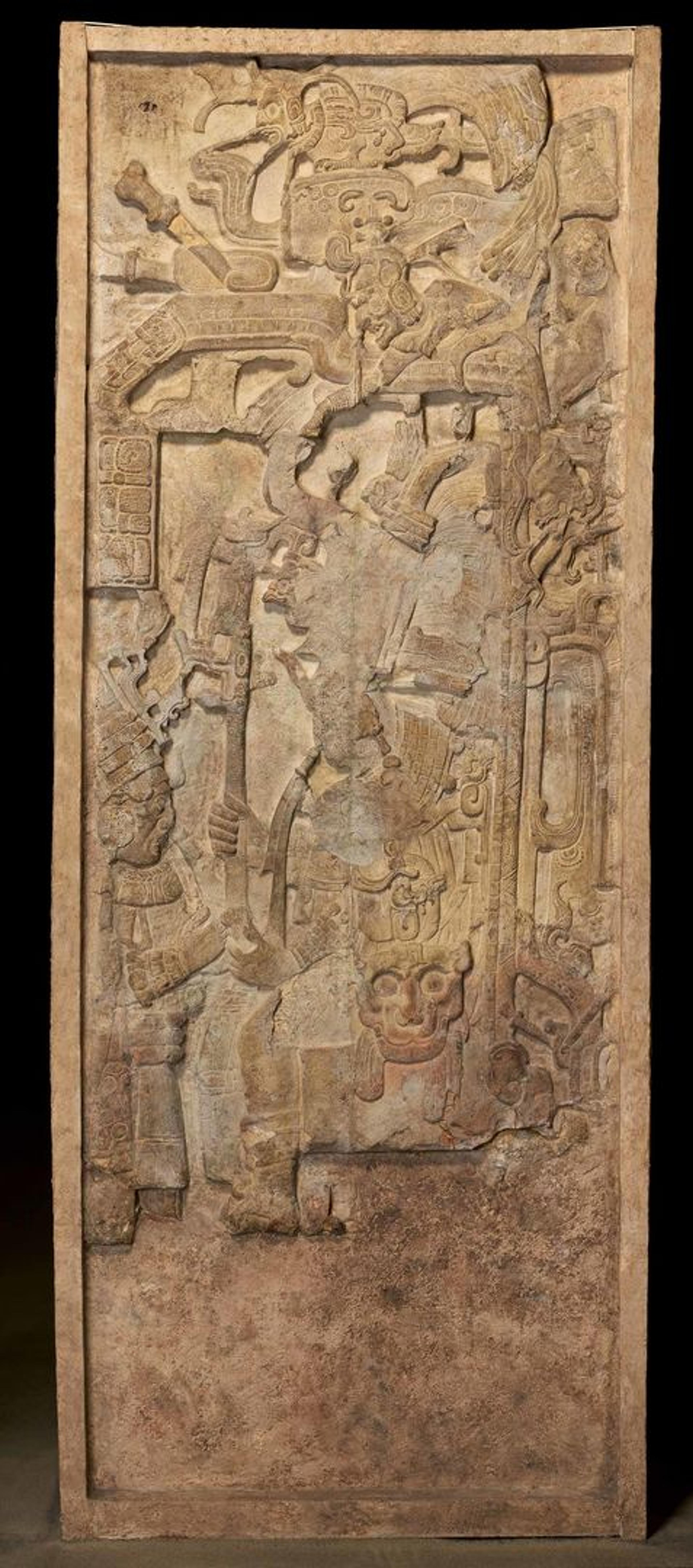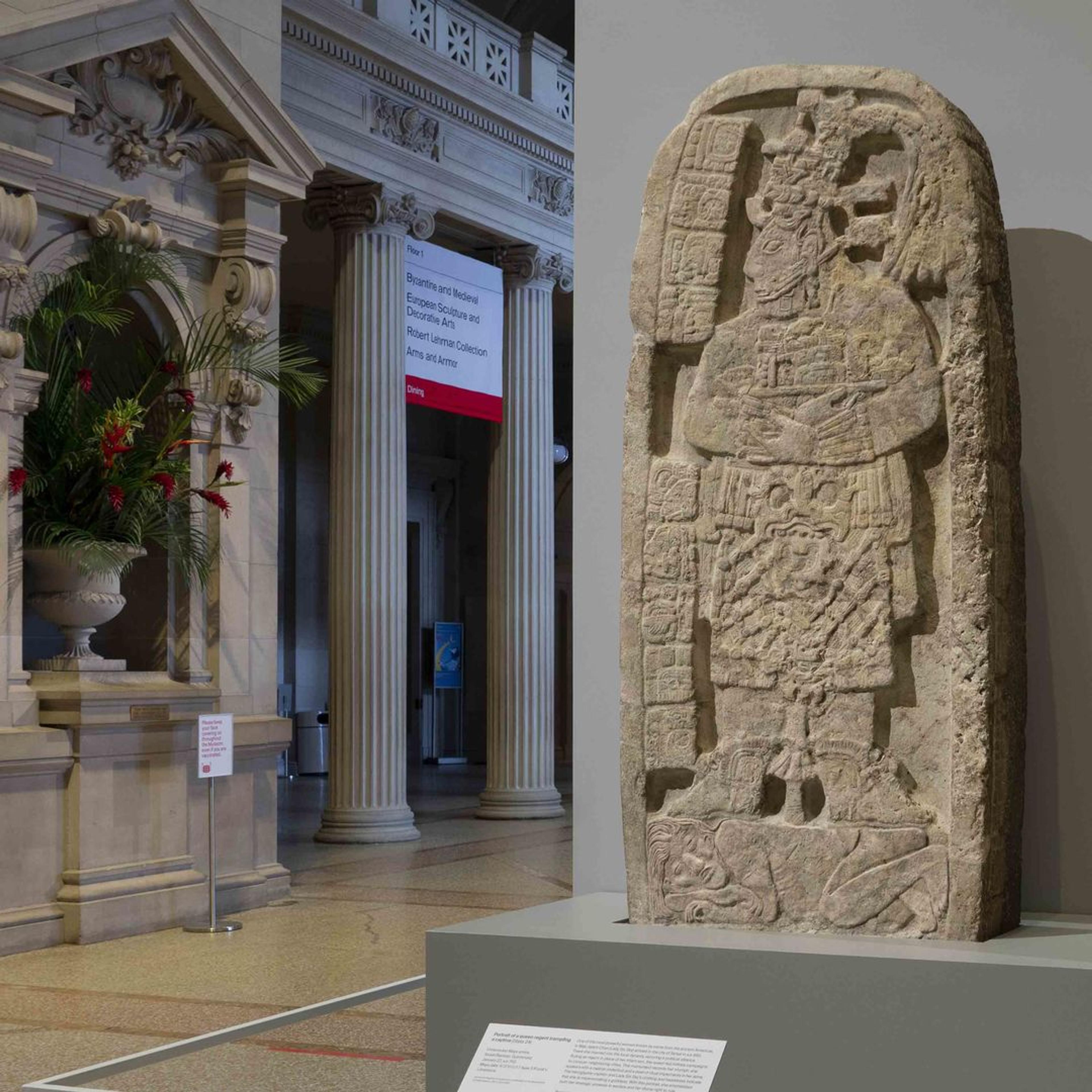Artists in first-millennium Maya royal courts created enduring, life-sized portraits of their patrons on freestanding stone monuments known as stelae. Such majestic images of powerful kings and queens who ruled over city-states in what is now southern Mexico, Guatemala, Belize, Honduras, and El Salvador also contain hieroglyphic texts. [1] These historic accounts record the passage of time and the biographies of powerful people and deities. [2] [3] Known in the ancient script as tuun or lakam tuun, meaning “stone” or “great stone,” stelae embody layered meanings: they physically mark sacred space, represent monumental versions of ceremonial axes or blades, and convey the conceptual radiance of stones extracted from the powerful earth. [4]
A new installation of two stelae opening on September 2, 2021, in the Great Hall features images of two great ancient Maya rulers gazing over crowds of contemporary museum goers, just as they would have originally observed public life in grand plazas. This effort foregrounds the long-term collaboration between the The Met and the Republic of Guatemala to display masterpieces of Maya relief sculpture in New York. Visitors will be able to encounter the representations of two powerful Indigenous American rulers while the Museum’s galleries for ancient American art undergo a transformative reenvisioning. The Michael C. Rockefeller Wing is scheduled to reopen in 2024.
The installation also serves as a preview of the upcoming exhibition Lives of the Gods: Divinity in Maya Art. Slated to open in fall 2022 and organized with the Kimbell Art Museum in Fort Worth, Texas, it will highlight Maya visual narratives featuring a cast of sacred beings who personified elements of the cosmos, nature, and agriculture. As part of the long-term collaboration, two additional works from the Republic of Guatemala will be treated by The Met's conservation team alongside conservators from Guatemala.
Yok’ib (Piedras Negras)

Portrait of a seated ruler receiving a noble (Stela 5). Unrecorded Maya artists, Yok’ib (Piedras Negras, Guatemala). November 2, A.D. 716, Maya date: 9.14.5.0.0 12 Ajaw 8 K’ank’in. Limestone, pigment. Lent by the Republic of Guatemala (L.1970.78)
The powerful king K’inich Yo’nal Ahk II (ca. 664–729) ruled the urban center of Yok’ib, on the modern-day border between Guatemala and Chiapas, Mexico, for more than four decades. To assert his authority, he commissioned royal sculptors to create a row of monuments, including this one, at the base of the city’s massive palace complex. Here the artists portrayed the king in a supernatural moment, enthroned as deities emerge from the jaws of a living mountain overhead. The lord’s bench is adorned with a jaguar skin; the feline’s empty eyes stare out at the viewer.
A skeletal figure in the upper right, perhaps a monstrous firefly, smokes a cigar (itself often an indicator of nighttime, according to Maya artistic conventions) and reaches out toward the seated lord. A large avian deity, perches atop the mountain throne and surveys the scene. On the left, a sajal, or noble, crosses an arm over his chest in a gesture of submission. In this way, the artists fused historical reality with divine actions, making the king the protagonist of this legendary scene.
Following the monument’s dedication, iconoclasts in ancient times, perhaps rivals who entered the city long after the ruler’s reign, chipped away the face of K’inich Yo’nal Ahk II, rendering his stony gaze powerless. After his death, the accomplished ruler was buried near his monuments in the richest tomb discovered at Yok’ib. The Met has supported recent excavation and conservation efforts at Piedras Negras which are led by a team of Guatemalan archaeologists and conservators.
Sa’aal (Naranjo)

Portrait of a queen regent trampling a captive (Stela 24). Unrecorded Maya artists, Sa’aal (Naranjo, Guatemala). January 22, A.D. 702, Maya date: 9.13.10.0.0 7 Ajaw 3 K’umk’u. Limestone. Lent by the Republic of Guatemala in celebration of the Bicentennial of Independence, 2021 (L.2021.28.1). MUNAE 15213, Registro 1.1.1.11100. Courtesy Ministerio de Cultura y Deportes de Guatemala. © Archivo Digital MUNAE
One of the most powerful women known by name from the ancient Americas, Ix Wak Jalam Chan (Lady Six Sky) arrived in the city of Sa’aal, now near the border between Belize and Guatemala, in 682. The daughter of a powerful ruler in a centuries-old dynasty, she married into the local ruling family, securing a critical political alliance. Ruling as regent in place of her infant son, the queen led military campaigns to conquer neighboring cities in the late seventh and early eighth centuries. This monument records her triumph: she appears with a captive underfoot and a bowl of ritual implements in her arms.
The hieroglyphic caption also indicates that she is impersonating a goddess. The artists portrays Lady Six Sky with spiritually charged regalia, including a woven skirt with jade beads, an elaborate belt assemblage featuring a supernatural watery being and Spondylus shell, and a feathered headdress, emphasizing the fluidity of identity between human leaders and gods. With this portrait, she underscored both her strategic prowess in warfare and her divine right to rule. In recent years, archaeological discoveries have revealed crucial new findings on the role of powerful women, such as Lady Six Sky, across the ancient Americas.
Maya Art at The Met

Loans from Guatemala on view in the special exhibition Before Cortés: Sculpture of Middle America. Download the catalogue here for free.
Beginning with the exhibition Maya Art from Guatemalain1968–69, The Met has collaborated with the Republic of Guatemala on several loans for temporary exhibition and long-term view. This includes the centennial exhibition, Before Cortés: Sculpture in Middle America, which featured a large number of works from the Guatemalan national collection and marked a turning point in public awareness of the greatness of Maya sculptors. The 2006 exhibition Treasures of Sacred Maya Kings: Lords of Creation and 2018–19’s Golden Kingdoms: Luxury and Legacy in the Ancient Americas also included recent archaeological discoveries from the country.
Portrait of a seated ruler receiving a noble (Stela 5) from Piedras Negras has been on loan to The Met since 1970, when Nelson Rockefeller returned the title of the monument to Guatemala in collaboration with then-President Julio César Méndez Montenegro, cementing a pioneering binational relationship that endures today.
Visitors to The Michael C. Rockefeller Wing since 1982 have enjoyed this sculpture in conversation with other highlights of Maya art, including finely painted ceramic vessels that also contain tales of gods and rulers.
[1] Miller, Mary Ellen and Megan O’Neil. Maya Art and Architecture. New York, Thames & Hudson, 2014. Return
[2] Martin, Simon. Ancient Maya Politics: A Political Anthropology of the Classic Period 150-900 CE. Cambridge, Cambridge University Press, 2020. Return
[3] Chinchilla Mazariegos, Oswaldo. Art and Myth of the Ancient Maya. New Haven, Yale University Press, 2017. Return
[4] Stuart, David. “Shining Stones: Observations on the Ritual Meaning of Early Maya Stelae.” In The Place of Stone Monuments: Context, Use, and Meaning in Mesoamerica’s Preclassic Transition, edited by Julia Guernsey, John E. Clark, and Barbara Arroyo, pp. 283-298. Washington, Dumbarton Oaks, 2010. Return
